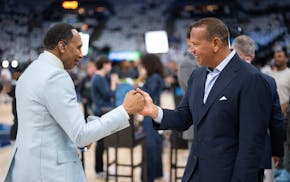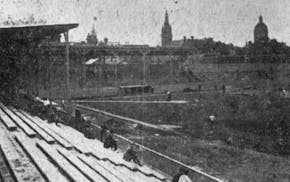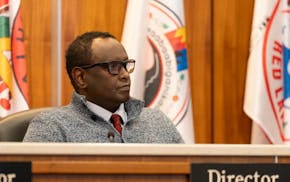James Griffin fired his gun at someone only once during his 42 years as a St. Paul cop.
On a day off in September 1949, Griffin was heading back to his home at 587 Rondo Street after a movie when he learned a liquor store bandit had fatally shot a police detective and was holed up in a nearby apartment building. Tear gas had been fired into the room where the suspect was hiding under a bed.
"They had two gas masks and asked for volunteers," Griffin told me in 1999, still unsure why he'd raised his hand 50 years earlier. "Don't ask me why. After I started up the stairs, I said to myself I was probably the biggest damn fool in history. I was scared to death and could hardly breathe."
Griffin and fellow officers converged on the suspect, killing him in a 12-shot barrage. Seventy-five years later, Griffin popped into my mind for a far less dramatic but more noteworthy anniversary.
On Oct. 6, 1972, Griffin became St. Paul's first African American deputy police chief. The promotion came only after Griffin threatened to sue the city's Civil Service office for passing him over despite finishing first on the deputy chief exam.
"I've had to fight for everything I got in the police," Griffin said in a 1998 Minnesota Public Radio interview, four years before he died at 85.
The son of a Northern Pacific dining-car waiter, James Stafford Griffin was born in 1917 in the family home on Rondo, a Black neighborhood carved up in the 1960s to make way for Interstate 94. He attended Central High School, where the football stadium was named for him in 1988.
Griffin met his wife, Edna Smoot, when they attended West Virginia State College, a historically Black college, during the Great Depression. He left school early to find work, eventually receiving his degree from Metropolitan State University in St. Paul in the early 1970s.
From 1921 to 1937, the St. Paul Police Department hired no Black cops. When Griffin joined the St. Paul police in 1941 as a reserve patrolman at the age of 24, he joined only three other African Americans on the force. He walked beats in some of St. Paul's roughest areas because only white cops got to ride in squad cars.
Griffin confronted the chief about that discrimination and became the first Black officer to use a squad car in 1946. He went on to become the department's first Black captain in 1970, when only three of the department's 350 men were Black.
"Jim Griffin was a pillar in St. Paul who understood the down-low racism in the police department and knew how to navigate the St. Paul establishment," William Finney, who became the city's first Black police chief in 1992, told me during a recent phone interview.
Finney, 75, knew Griffin his whole life. Griffin and Finney's uncle, LeRoy Coleman, were old friends from Rondo. They all attended St. Philip's Episcopal Church on Mackubin Street in St. Paul.
Finney explained how in 1972, when Griffin at first was passed over for deputy chief, Civil Service rules allowed for hiring any of the top three candidates ranked by test scores.
"But when Jimmy finished first on the deputy chief test, it was the first time in 30 years they hadn't just taken the top guy," Finney said.
The job instead went to William McCutcheon, a white state senator who was in police administration. "Jim felt his ox had been gored," Finney said. "So he hired the hot shot lawyer of the time, Doug Thomson. The city knew they were going to lose the lawsuit."
Police Chief Richard Rowan decided to keep McCutcheon in his job and created a fourth deputy chief position for Griffin. "They gave him a nothing department, making him in charge of the impound lot and the janitors," Finney said. "But the salary was the same."
When McCutcheon became St. Paul's police chief in 1980, the department reverted to three deputy chiefs, who are now appointed by the chief rather than through Civil Service. Another interesting tidbit: Rowan, the chief who promoted Griffin to deputy chief, was a patrolman on the scene at the 1949 liquor store robbery and shot at the suspect early in the chase.
Along with his four decades on the police force, Griffin spent 17 years as the lone person of color on the St. Paul School Board. He also worked as a high school sports official across the state, earning money to help pay for his three daughters' college tuitions.
"I'd officiate from Bemidji to Austin to Zumbrota, everywhere," he said in 1988, adding: "I'd be the only Black guy they'd see until the next year when I'd come back."
There were times while walking the police beat when Griffin wanted to quit.
"You have to remember, there was no freedom of movement for young Black men back then," he told Star Tribune columnist Doug Grow in 1992. "If you were a young Black man and had a job at all, you were damn lucky. So I kept doing my job and tried to keep my mouth shut."
Today, about 35% of St. Paul's 557 sworn police officers are people of color, including about 8% who are African American. That's far better than in Griffin's day, though those figures lag behind the total populations of those communities in the city as a whole.
A few days after Griffin died in November 2002, the St. Paul City Council voted unanimously to name the city's new Grove Street police headquarters the James S. Griffin Building.
"Most of the good things that have happened to me took place within a 2-mile radius of where I was born," such as his namesake stadium and the place he was named assistant chief, Griffin told the Star Tribune in 1990. "I think that proves that you don't have to leave home to make your mark."
Curt Brown's tales about Minnesota's history appear every other Sunday. Readers can send him ideas and suggestions at mnhistory@startribune.com. His latest book looks at 1918 Minnesota, when flu, war and fires converged: strib.mn/MN1918.
Man charged with murder in January death of Jordan woman

Celebrity Wolves fans spotted at Game 3

A history buff's quest to mark St. Paul's 'pillbox' ballpark
Prostate experts see familiar scenario in Biden's cancer diagnosis

